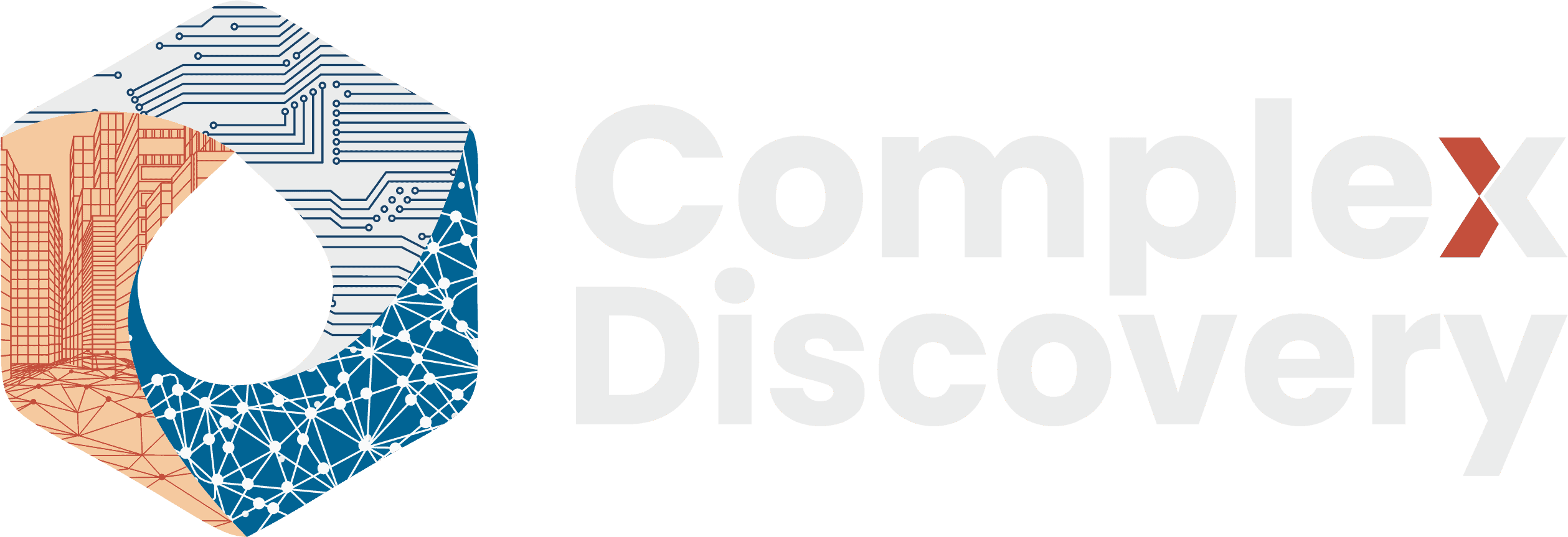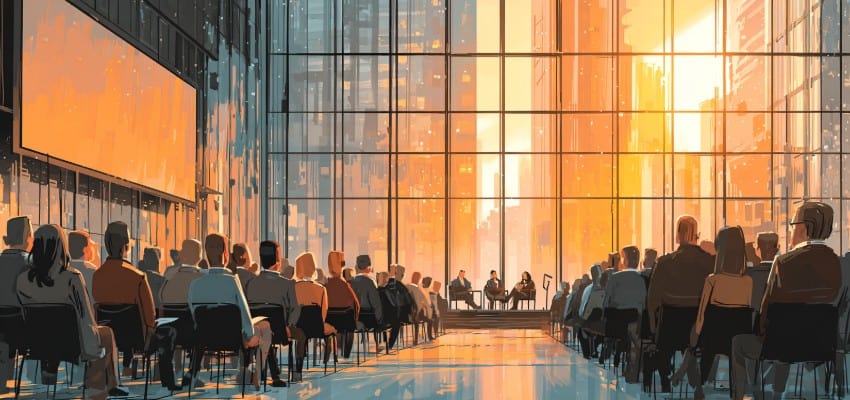Editor’s Note: Legal tech conferences are no longer just industry gatherings—they’re the new corporate boardrooms, performance venues, and marketplaces of influence. In this compelling article, the legal tech landscape is examined with a critical yet constructive lens, illuminating how post-pandemic events have evolved into high-stakes arenas shaped as much by fear as strategy. For professionals in cybersecurity, information governance, and eDiscovery, this piece offers a vital reframing of what these events truly deliver—and what they may be costing in the name of presence.
By unpacking the motivations, anxieties, and decision-making traps behind sponsorships and attendance, this article prompts a deeper strategic reflection: are your event investments driving value, or simply maintaining visibility? It’s an essential read for leaders who want to reshape their engagement model for maximum impact—not just presence.
Content Assessment: The New Office of Influence: Inside the Fear and Theatre of Legal Tech Events
Information - 94%
Insight - 95%
Relevance - 90%
Objectivity - 88%
Authority - 90%
91%
Excellent
A short percentage-based assessment of the qualitative benefit expressed as a percentage of positive reception of the recent article from ComplexDiscovery OÜ titled, "The New Office of Influence: Inside the Fear and Theatre of Legal Tech Events."
Industry News – eDiscovery Beat
The New Office of Influence: Inside the Fear and Theatre of Legal Tech Events
ComplexDiscovery Staff
At a major legal technology conference last spring, a marketing director stood frozen in the exhibition hall, phone pressed to her ear. Her competitor had just announced a platinum sponsorship for next quarter’s event—$75,000 for prime booth placement, speaking slots, and their logo splashed across every registration email. “We can’t not match this,” she told her CEO, her voice carrying a mix of resignation and panic. “Everyone will think we’re struggling.”
This approach wasn’t strategy. It was fear. And it perfectly captures one dimension of legal technology’s complex event ecosystem: a multi-million dollar industry where attendance has evolved into something far more nuanced than simple networking, and where the fear of irrelevance has become as powerful as the promise of connection.
This article is an informed industry observation, drawn from years of watching the legal technology events landscape evolve. While many events deliver exceptional value exactly as they are—fostering genuine innovation, enabling crucial partnerships, and advancing the profession—there’s a parallel story worth examining about how post-pandemic professional gatherings have transformed into something entirely new: the office of influence.
When Event Conference Rooms Became the Office
The pandemic didn’t just change where we work—it fundamentally altered why we gather. Legal technology events, once optional additions to the business calendar, morphed into something more complex after COVID-19 scattered teams across time zones and home offices. The spatial anchor of the traditional office disappeared, and events rushed to fill the void.
Walking through any major legal tech conference today reveals this transformation in action. In one corner suite, a distributed team holds its quarterly planning session—an activity that once happened in a corporate conference room. By the cocktail reception, two executives hash out partnership details that previously would have been handled in a series of office meetings. Near the coffee station, a manager provides career guidance to a junior team member they’ve only known through screens for two years.
These gatherings have become the primary venue for activities that once happened organically in office buildings. Team building moved from company retreats to “let’s all meet at the conference.” Strategic planning migrated from boardrooms to hotel suites. Even performance reviews increasingly happen in the margins of industry gatherings.
The evolution makes sense. When your team spans three time zones and five states, the conference becomes the one reliable opportunity for face-to-face connection. The hotel lobby becomes the water cooler. The breakfast buffet becomes the break room. The evening reception becomes the after-work gathering spot.
Events stopped being about events. They became about everything else.
The Architecture of Anxiety
Fear of missing out drives more than social media behavior—it’s now a primary engine of corporate event spending. But this isn’t casual anxiety. It’s systematic, carefully cultivated, and remarkably effective.
The email arrives on a Tuesday morning. “Only three platinum sponsorships remaining!” it declares, though the event is four months away. By lunch, another message: “Your competitors have already confirmed their participation.” The marketing director, despite knowing these are tactics, feels her pulse quicken. She’s seen this play before, but that doesn’t make her immune to its effects.
Many event organizers have mastered the psychology of professional insecurity. They create artificial scarcity, knowing that “limited availability” triggers action faster than any ROI calculation. They orchestrate social proof cascades, announcing big-name sponsors early to create pressure for others to follow. They design tier systems—Bronze, Silver, Gold, Platinum, Diamond—that have less to do with actual benefits and more to do with relative status.
The most sophisticated organizers understand they’re not selling conference space. They’re navigating the delicate balance between creating valuable gatherings and monetizing professional anxiety. Every email about “exclusive opportunities” walks the line between legitimate value proposition and manufactured urgency.
Three Perspectives from Inside the Circuit
The ecosystem sustains itself through interconnected actors, each navigating the space with different motivations and pressures.
The Sales Representative’s Dilemma
A sales director at a growing legal tech startup sits in a budget meeting, advocating passionately for a $50,000 platinum sponsorship. The fascinating detail: the money comes from the marketing budget, not the sales quota. The financial risk of the investment, should it fail to generate returns, doesn’t directly impact the person advocating most strongly for it.
The calculus running through this person’s mind is devastatingly simple. Being visible at the event and landing one deal makes them a hero. Being visible and landing nothing can be explained away—”at least we maintained presence.” But being absent while a competitor succeeds? That’s career risk. Being absent when nothing happens still means worrying the entire time about what might have been missed.
“You can’t prove the deals I didn’t get because I wasn’t there” becomes an unassailable argument for perpetual presence. The house always wins because the house is built on anxiety. The push for spending comes not from data supporting it, but from visibility having become a professional self-preservation tactic.
The Event Organizer’s Balance
Modern event organizers navigate a complex challenge. They must create genuine value while managing the commercial realities of event production. The successful ones understand that sustainable events require balancing the needs of multiple stakeholders.
They’ve learned that urgency motivates faster than patient explanation ever could. Creating sponsorship tiers serves dual purposes—it funds the event while allowing companies to self-select their involvement level. Starting with a premium “Title Sponsorship” at $150,000 makes the $50,000 platinum package feel reasonable by comparison. Package deals combine valuable elements, such as speaking slots, with standard benefits like logo placement, to create comprehensive partnership opportunities.
The best organizers recognize they’re not just event producers—they’re community builders navigating the tensions between commercial viability and authentic value creation. They understand that every “limited remaining sponsorships” message must balance genuine opportunity with realistic availability.
The Visible Professional
Then there’s the new category of professional—those who’ve turned presence into a profession. These presence professionals don’t just attend events; they document attendance. Their LinkedIn feeds showcase careful choreography: morning photos with keynote speakers, afternoon posts about “amazing conversations,” evening updates from VIP receptions, and next-day “key takeaways” that sound profound while saying little specific.
But they’re providing a service the ecosystem seems to need: validation. When the “industry thought leader” posts about an event being “can’t-miss,” they’re confirming the decision of everyone who paid to be there and stoking anxiety in everyone who didn’t. They’ve become the social proof that keeps the wheel spinning.
The incentive structure creates perfect symbiosis. Organizers need these visible professionals to amplify their events. Professionals need events to maintain their relevance. Sponsors need both to justify their spending. Everyone needs everyone else to keep the ecosystem functioning.
Uncomfortable Observations
Years of observation reveal patterns that, while not universal, appear often enough to merit discussion.
At many legal tech events, a significant portion of attendees are vendors trying to connect with decision-making legal professionals. It’s a marketplace where sellers often outnumber buyers. The actual legal professionals—the supposed target audience—sometimes comprise fewer than a third of the attendees.
The same speakers often rotate through the circuit, delivering similar presentations with updated slides. “Digital transformation,” “AI revolution,” and “the future of law” have become templates where only the dates and minor details change. Despite conferences promoting “education” and “thought leadership,” actual knowledge transfer can be minimal. Many attendees struggle to recall specific actionable insights from events they’ve attended.
The pay-to-play model can systematically exclude smaller firms, diverse voices, and innovative startups that can’t afford the table stakes. The same voices dominate to some extent because they’re the ones who can afford the sponsorship that comes with the speaking slot.
The environmental impact remains another consideration—the carbon footprint of major conferences, the disposable materials, the travel required—though this concern exists alongside the genuine value of in-person connection.
Many companies struggle to articulate their event ROI because they don’t consistently measure it. When pressed, marketing directors point to “brand awareness” or “relationship building”—metrics so vague they resist falsification. Some avoid measurement, suspecting what they might find.
For some attendees, being at events has become their primary professional activity. They’re professional participants whose value proposition is being seen rather than what they accomplish between events.
A Framework for Strategic Participation
Understanding that different events serve different purposes allows for more strategic participation. Not every gathering requires the same approach or level of investment.
Theatre Events: The Performance Spaces
These are the big industry showcases where visibility is the primary product. The main stages where the industry performs for itself. Companies that participate might consider buying the minimal viable presence and never the highest level unless launching something significant. Focusing spending on two or three key initiatives per year and measuring success by brand mentions and media coverage, rather than booth traffic, provides a clearer ROI. Everyone else is performing too—the actual audience of decision-makers is often smaller than the attendance list suggests.
Classroom Events: The Learning Laboratories
Smaller, focused gatherings with genuine educational value represent a distinct category altogether. The investment here isn’t sponsorship—it’s expertise. Sending the smartest team members rather than the best salespeople, contributing knowledge through speaking or leading workshops, and skipping the booth entirely can demonstrate that authority isn’t bought but earned. Success metrics shift to the implementation of ideas learned rather than business cards collected.
Marketplace Events: The Deal Rooms
Targeted gatherings where actual buyers congregate represent the most straightforward value proposition. Here, simple attendance often suffices. Skipping sponsorships entirely and just buying tickets, focusing on quality conversations over quantity, and investing savings in follow-up activities can yield better results. Success is measured by the number of qualified leads generated per dollar spent.
Most companies treat all events like Theatre Events, investing heavily in visibility when they should be selective about where they perform, learn, and sell.
The $50,000 Question
That platinum sponsorship could instead fund a year-long thought leadership campaign with original research. Or five high-quality customer case study videos. Or ten executive dinner events in target markets. Or fifty hours of expert consulting to improve the actual product. Or certification training for an entire sales team. Or a scholarship program for diverse legal professionals that generates far better PR than any booth ever could.
Some forward-thinking companies are discovering the power of selective absence. When everyone else is at the mega-conference, they’re hosting intimate client workshops, building better products, creating content that outlasts any booth, and calling prospects who are tired of being pitched at events.
The message their absence sends isn’t “we can’t afford it” but “we’re too busy delivering value to perform in the circus.”
Imagining Better Models
The future won’t come from wholesale rejection of events—many serve crucial industry functions perfectly well as designed. But there’s room for innovation and alternatives.
The unconference model, with participant-driven agendas where attendees propose and lead sessions, eliminates hierarchy and creates peer-to-peer value. The legal tech industry could learn from the tech sector, where these formats often produce more actionable insights than traditional conferences.
Teaching tournaments where vendors compete on education quality rather than booth size could reshape the landscape. Imagine sponsors earning visibility by delivering the best training, not writing the biggest check. Speaking slots are awarded based on audience ratings from previous events rather than sponsorship tier.
Problem-solving summits organized around specific challenges, rather than general themes—”Fixing Document Review” rather than “The Future of Legal Tech”—could deliver immediate value. Attendees bring actual problems and leave with actual solutions. Success is measured by problems solved, not attendance figures.
High-quality virtual-first hybrids with in-person as a premium add-on aren’t about post-pandemic necessity but about recognizing that the best insights shouldn’t require airfare. Recording everything, making it searchable, and creating lasting value extends impact beyond the event dates.
Expertise exchanges where every attendee must teach something to attend eliminate passive participation. Want to learn? Come ready to share. This approach immediately filters for engaged participants and creates reciprocal value.
The Path Forward
The legal tech events industry stands at an inflection point. The current model—which ranges from highly valuable gatherings that advance the profession to others built primarily on fear and optimized for monetary extraction—faces growing scrutiny. Companies are beginning to question returns. Professionals are experiencing event fatigue. The performance aspect is becoming harder to ignore.
The marketing director from the opening scene has a choice that extends beyond this quarter’s event. She could continue the performance, sign the platinum check, and maintain the status quo. Or she could ask the questions that need asking: What did we actually gain from last year’s spending? Who are we trying to impress, and why does their opinion matter? What could we build with this money instead? Are we solving problems or just performing solutions?
The paradox is striking. In an industry seeking innovation and efficiency, we’ve positively preserved some of the most traditional aspects of business culture. While technology has transformed how we work, the human need for connection, validation, and visibility remains remarkably constant. The challenge isn’t to eliminate these gatherings but to ensure they serve genuine purposes beyond performance.
Finding Balance
The next time an urgent email arrives about “remaining sponsorship opportunities,” or that familiar anxiety about missing the next big event surfaces, it’s worth pausing. The question isn’t whether to participate—many events deliver exceptional value exactly as they are. The question is whether each specific investment serves growth or simply insures against fear. Whether it builds value or merely performs.
The new office of influence doesn’t have to be pure theatre. Many events already function as genuine marketplaces of ideas where value is created, not just displayed, where learning happens alongside selling, and where substance and spectacle can coexist.
The companies that thrive in the next decade won’t necessarily be the ones with the biggest booths or the most speaking slots. They’ll be the ones who choose strategically—who understand when to show up and when to stay home, when to sponsor and when to simply attend, when to perform and when to produce.
The lobby still hums with nervous energy. Deals are still being made. Connections are still forming. Innovation is still happening. However, increasingly, the most astute players are making deliberate choices about where and how to engage. They’re not missing out—they’ve simply found the right balance between presence and production, between visibility and value.
The new office of influence continues evolving. Some events will remain exactly as they are—valuable gathering points that serve the industry well. Others will innovate and experiment with new models. The market will ultimately decide which approaches deliver the most value.
But one thing is certain: the conversation about why we gather, how we gather, and what we hope to achieve when we gather has never been more important. In that conversation lies the opportunity not to tear down what works, but to build additional models that serve different needs—to create an ecosystem where every investment, whether in a platinum sponsorship or a simple attendee ticket, delivers measurable value.
The fear of missing out has built an entire economy. Perhaps it’s time to balance that fear with confidence—confidence that strategic choices outperform reflexive participation, that value creation surpasses visibility performance, and that the most effective way to influence an industry is to help it solve real problems.
The marketing director ended that phone call without committing to the platinum sponsorship. She asked for time to think, to measure, to strategize. In that pause lies wisdom. Not every event requires the same response. Not every opportunity is actually an opportunity. And sometimes, the most influential thing you can do is to be intentional about when, where, and how you show up.
The new office of influence is still being built. It will include the grand theatres and the intimate classrooms, the virtual summits and the in-person gatherings, the massive conferences that define industries, and the small meetings that change careers. There’s room for all of it—as long as we’re honest about what we’re buying, what we’re building, and what we’re hoping to achieve.
That’s not a criticism of what exists. It’s an invitation to make it even better.
Postscript: The Velocity Trap
There’s one more pattern worth noting—perhaps the most insidious of all. Many organizations have become trapped on a hamster wheel of participation, where the velocity of attendance far exceeds their capability to develop the benefits of that attendance. They’re moving from event to event so quickly that the opportunities gained from one gathering remain unexplored before the team is packing for the next.
A business development director returns from a conference with 47 promising conversations documented in hastily scrawled notes and business cards. But before those conversations can be properly followed up, analyzed for potential, and nurtured into relationships, she’s preparing for next week’s summit. Those 47 conversations become 47 LinkedIn connection requests sent in bulk from an airport lounge, most never to be meaningfully engaged again.
The CRM fills with “leads” that are really just names. The follow-up emails that should happen within 48 hours happen after two weeks, if at all. The insights gathered from sessions get filed in folders marked “review later” that never get reviewed. The team that should be debriefing about what worked and what didn’t is already planning the next booth layout.
This velocity trap creates a cruel irony. Companies invest heavily in events to generate opportunities, then move so fast between events that they lack the time to capitalize on those opportunities. It’s like buying seeds by the truckload but never stopping long enough to plant them.
The mathematics are unforgiving. Converting a meaningful conference connection into a business relationship typically requires five to seven thoughtful touchpoints over several weeks. But when your team attends an event every two weeks, when does this cultivation happen? The result is surface-level engagement everywhere and depth nowhere.
There’s also a critical distinction that gets lost in the acceleration: buying a list of contacts through event sponsorship is fundamentally different from developing contacts that can be meaningfully followed up with by the individual responsible for closing the last three feet with the contact. The platinum sponsorship might come with “exclusive access to attendee data”—500 names and email addresses. But these cold contacts, acquired transactionally, convert at a fraction of the rate of the five genuine conversations held over coffee between sessions.
Yet organizations often conflate the two, counting purchased lists as equivalent to cultivated relationships. They report “500 new leads from the event” when what they really have is 495 email addresses that will likely mark their outreach as spam and five real conversations that could become something—if only there were time to nurture them before the next event.
The most successful companies in the space are discovering a different rhythm. They attend fewer events but arrive better prepared. They send smaller teams but empower them to go deeper. They measure success not by badges scanned but by relationships developed six months later. They understand that the real work of an event begins when you return to the office, not when you arrive at the venue.
In this light, the marketing director’s pause becomes even more significant. The question isn’t just whether to sponsor the next event, but whether the organization has fully absorbed the lessons from the last one. Sometimes the most strategic move isn’t to attend the next gathering—it’s to finally, fully develop the opportunities from the previous five.
The hamster wheel only stops when someone stops running.
The views expressed in this article are based on personal industry observation and experience. They do not represent the official position of any company, client, or event the author works with or for. The goal is to encourage thoughtful dialogue and strategic reflection—not to critique specific gatherings, but to explore how the legal tech community might more effectively align event participation with long-term value.
Assisted by GAI and LLM Technologies
Additional Reading
- The Agentic State: A Global Framework for Secure and Accountable AI-Powered Government
- From Bates Stamps to Bots: ILTACON Roundtable Traces Legal Tech’s Leap from TAR to AI
- Managing Emerging Data in eDiscovery: Lessons from LegalTechTalk 2025
- Legalweek 2025: Judges Signal New Competency Standards in AI-Era Discovery
- SXSW EDU | Embracing the Experimental Mindset: How Curiosity Fuels Learning and Growth
Source: ComplexDiscovery OÜ






































